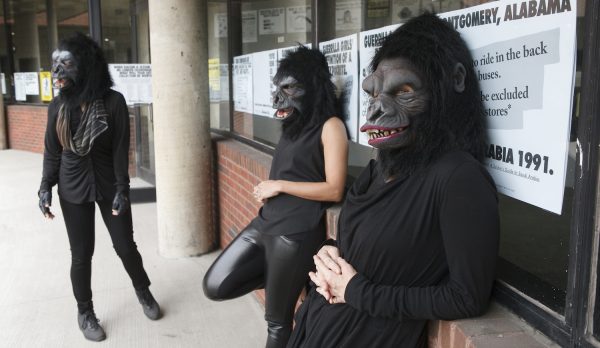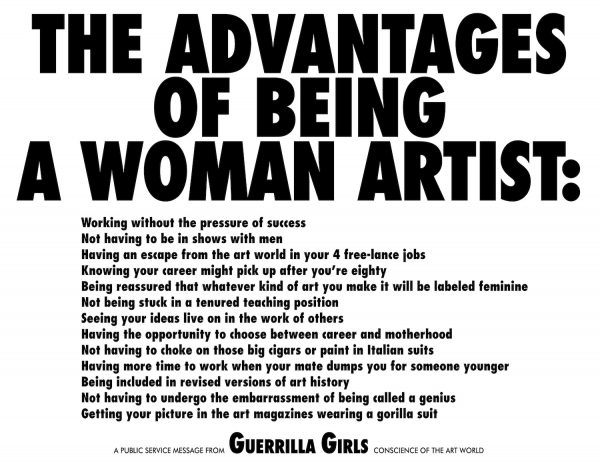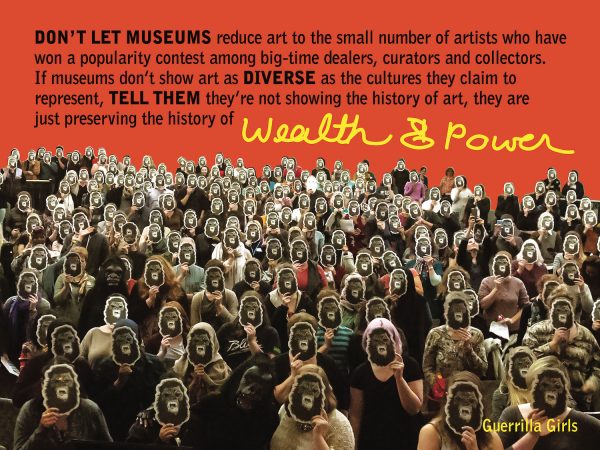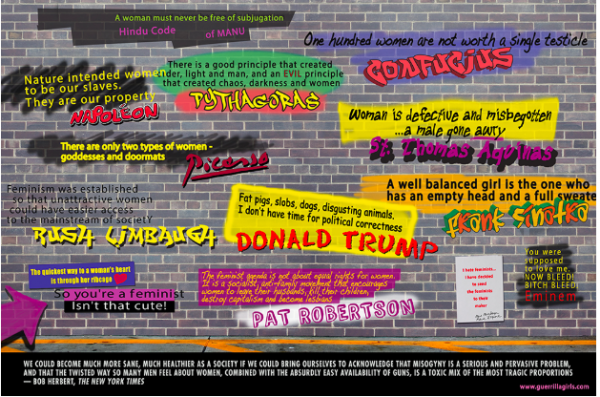
Guerrilla Girls artists Kathe Kollwitz, Zubeida Agha and Frida Kahlo during a press preview for an exhibition of works by the Guerrilla Girls titled “Not Ready To Make Nice: 30 Years And Still Counting,” at the Abrams Art Center, 466 Grand St, New York, NY on Thursday, April 30, 2015. Photograph by Andrew Hinderaker.
I first discovered the Guerrilla Girls’ work as a young undergrad at Pratt Institute in New York. In the 1980s, feminism and political art were not part of the academic canon in visual-arts education. GG work radically shifted my conception about not only the gender inequity in the art world, but the bias in how history is recorded and taught. The work also opened me up to the possibilities for engaging in a multi-faceted art practice that did not conform to traditional genres. Later, the Guerrilla Girls’ book Bedside Companion To The History of Western Art (1998) donned my bedside table, providing a much-needed counterpoint to the other art histories stacked there.
Over the past 33 years, 55 different artists have donned gorilla masks, engaging in protesting racial and gender inequality in the arts, film, and popular culture through performances, actions, publications, posters, stickers and exhibitions. Today, Friday Sept. 7, a show of GG works opens at the Safe Room in Dallas’ Texas Theatre, co-presented by Cydonia Gallery.
Colette Copeland: Congratulations on 33 years of creative resistance and activism. Employing the language and procedures of guerrilla warfare has proved a successful modus operandi for the group. A tenet of guerrilla warfare is to reverse tactics in order to wear down the enemy (in this case—white hegemony). Has the language of war become too familiar and/or comfortable for those in power and what might an alternative approach offer as subterfuge? What are some of the discussions surrounding GG future campaigns? Have you considered other tactics?
Guerrilla Girls: Thanks – It’s been a wild 33 years!
We would argue that the language and values of Big Money has become too familiar — the 1% have hijacked all aspects of our society, especially our cultural institutions. We believe in an alternative artworld that is not about auction records and cookie-cutter, blue-chip art collections. You don’t need to make precious expensive products to make a significant contribution to culture — the art world needs to become more accessible and affordable or it risks becoming irrelevant.
We always try to do something that is unforgettable and that does mean changing things up all the time. We try to figure out what will make people stop and think about things and end up questioning the artworld power structure, whether they are on the inside or the outside.
We consider humour our most powerful tactic. You can’t just point at something and say ‘This is bad’ — you have to craft your message, twist it around, and critique in a memorable way.
Our future campaigns will always be secret… stay tuned!
CC: The performative aspect of GG work utilizes absurdity and spectacle combined with statistical facts to indict and hold accountable media and institutions for their blatant discrimination. What role does subversive humor play as a strategical device for effecting change?
GG: We also like to call it the subversive use of information. We’ve found that if you can make someone who disagrees with you laugh, you have a hook into their brain and once there if you present them with facts you have a better chance to convert them!
CC: With the #metoo movement, individuals have been speaking out — sharing their stories, and showing their faces, breaking their silence and parting with anonymity. As a movement, the individual seems as important as the aggregate. Beyond the iconic image of the Guerrilla/Gorilla, what does the mask personify in your work today within the context of current socio-political culture? Are there any setbacks to being behind a mask?
GG: Our masks, our anonymity, do come with setbacks — it’s hot under those things! Mask hair! All the lies we have to tell friends to conceal our GG lives! Working on super exciting projects and not being able to tell everyone about it! But all kidding aside — we believe in anonymity — it flies in the face of the ego-driven artist archetype we are all fed in art school. When we started in 1985 the anonymity was important to protect ourselves and to keep the focus on the issues we complain about — not our personal lives. We’re heartened to see all the change in today’s activist culture but we think there will always be a place for anonymity.
The gorilla mask does have some baggage, and early on we worried about it. But we had the intention to reclaim cruel stereotypes and turn them on themselves: like the word “girl,” so often used to belittle women.
CC: I’ve always been impressed with GG emphasis on education and training on university campuses and in the general community, especially the focus on teaching successful activism practices beyond posters and merchandise. It seems more important than ever, not just for artists who do not receive this type of training in art school, but for the general public where culture is about more and more about conformity and acceptance, not resistance. What is the overall mission in terms of educational initiatives in GG practice and what will that look like for the future? What does #resist /resist mean to you? How can we weaponize #resist? How do you teach artists protest art? How do you teach activism?
GG: We don’t have “educational initiatives” but we’ve always loved speaking at colleges and universities. In fact educational communities have given us an art-world presence for years, from the very beginning. Our work is the production of knowledge as much as graphic posters and books. Talking directly to students allows us to tell everyone about this alternative art-world that we inhabit. A world that’s about collaboration, affordable art, and activism. We encourage artists to work together, listen to each other, question what they are being taught and most importantly, complain, complain, complain — but to complain creatively. We can’t predict what the future will look like but we hope it contains the energy and dedication of today’s activists.
CC: Describe the most unexpected or transformative encounter with a member of the patriarchy (i.e. Trump).
GG: Too many to count and too stupid to remember! But our 2009 project Disturbing the Peace lists some prime examples of hate speech against women and feminists from some of the patriarchy’s most beloved members.
In 2016 it seemed necessary to add a quote from Trump himself.
Let’s not forget that the art market has run on Trumpian values for years: profit at the top, exploitation at the bottom and little in the middle. Many of the corruption charges against the Trump administration — conflict of interest, insider trading, exploitation of employees, money laundering and tax evasion — have gone on in the art market for years and no one has said much about it.
CC: How does one apply to become a Guerrilla Girl? Is there a gender requirement? Have you had members who did not identify as female?
GG: There are no gender requirements for joining the Guerrilla Girls; we’ve had transgender and gender-nonconforming members since the beginning, but it’s hard to find cis men willing to work as hard as we do without recognition!
We would love to have everyone who wants to join the Guerrilla Girls be part of our gang — we get this question a lot. But the world doesn’t need more Guerrilla Girls — it needs more feminist masked avengers! We want to encourage people to form their own groups, champion their own messages, and find their own unique voice and name. We need a whole chorus of feminists. Just think of how much that will scare the patriarchy!
Again: today, Friday Sept. 7, a show of GG works opens at the Safe Room in Dallas’ Texas Theatre, co-presented by Cydonia Gallery.







